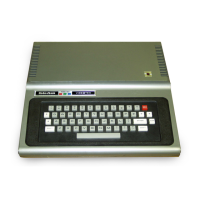Using the arrow keys, position the cursor over the letter G
of
the variable
AG
in line
40. When you have done this, line 40 should appear
as:
40
PRINT
"YOUR
AGE
IS!I~
Press
(BKSP)
to
delete the letter A. Line 40 now should appear
as
At this point, the editing is finished. Press
(ESC)
twice to exit from the Editor. List the
program to confirm it is:
10
INPUT
"YOUR
NAME";
N$
20
READ
A$, G
30
IF
A$
< >
N$
THEN
GOTO
20
a0
PRINT
"YOUR
AGE
IS",
G
50
DATA
DAN,
32,
RON,
38,
LINDA,
42
80
DATA
BETTY,
35,
RALPH,
28,
SKIP,
3
Execute the program to confirm that it
is
working correctly.
It
should be clcar that characters can bc easily deleted with the use of the Editor. You
need only remember to position the cursor one character to the right
of
the character to
be deleted.
Another very similar way to delete characters consists
of
entering the Editor,
positioning the cursor right over the character you wish to delete and then pressing
(DEL)
(CSHIFT)(BKSP)).
As with
(BKSP),
characters to the right of the deletion will shift to the left to fill the
vacant space.
Experiment
#4
Changing a Character
Here
is
the previous program again
as
it
currently exists
in
memory:
10
INPUT
"YOUR
NAME";
N$
20
READ
A$, G
30
IF
A$
< >
N$
THEN
GO
TO
20
a0
PRINT
"YOUR
AGE
IS",
G
50
DATA
DAN,
32,
RON,
38,
LINDA,
a2
80
DATA
BETTY,
35,
RALPH,
28,
SKIP,
3
The comma
in
line 40 will be changed to a semicolon so that the age will be printed
closer to the phrase
"YOUR
AGE
IS."
The comma specifies that the age will be
printed in the next field. The use
of
a semicolon, however, will eliminate all but one
space before the age. The change will be made with the Editor.
Enter the Editor with the command
ED
IT
(ENTER)
75

